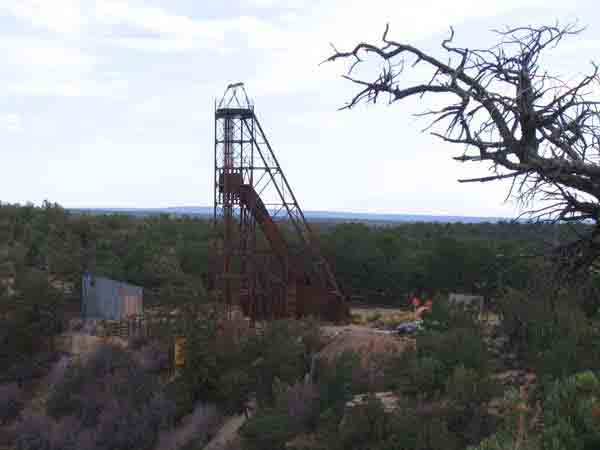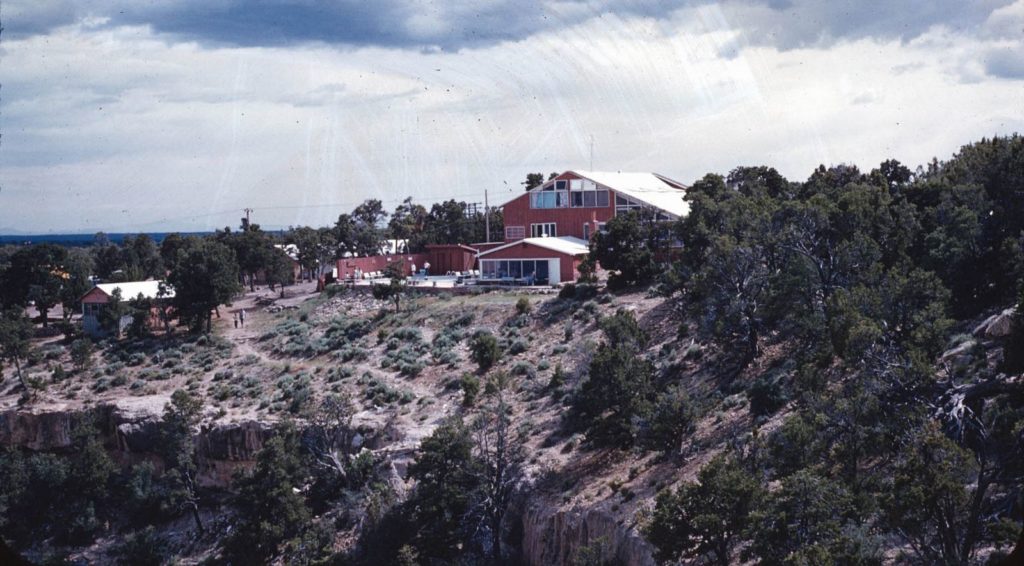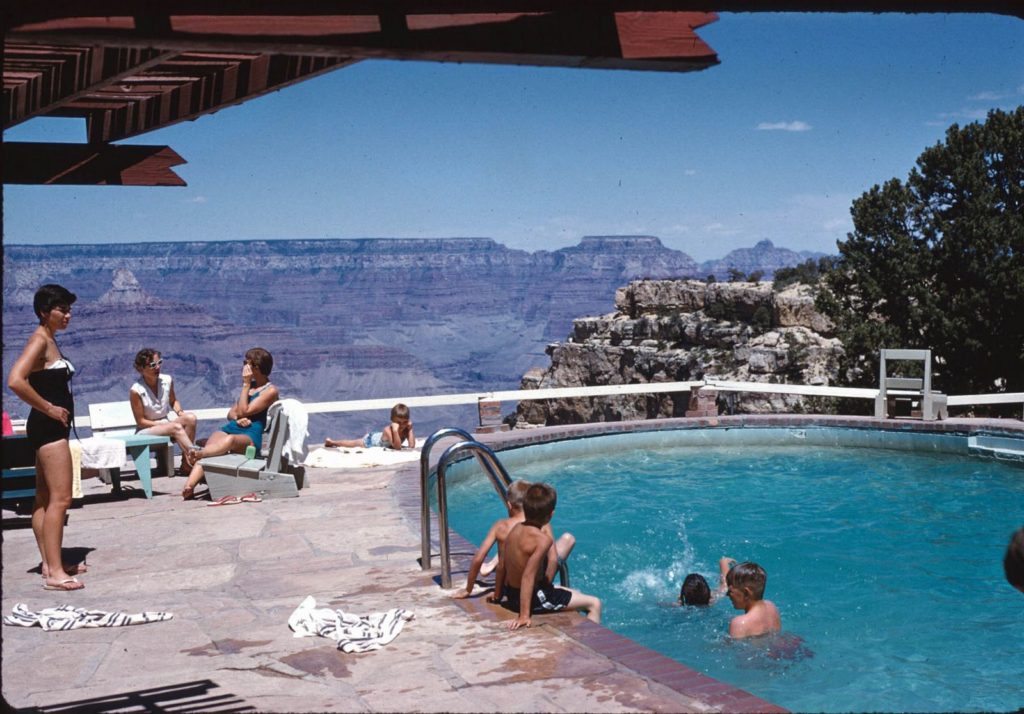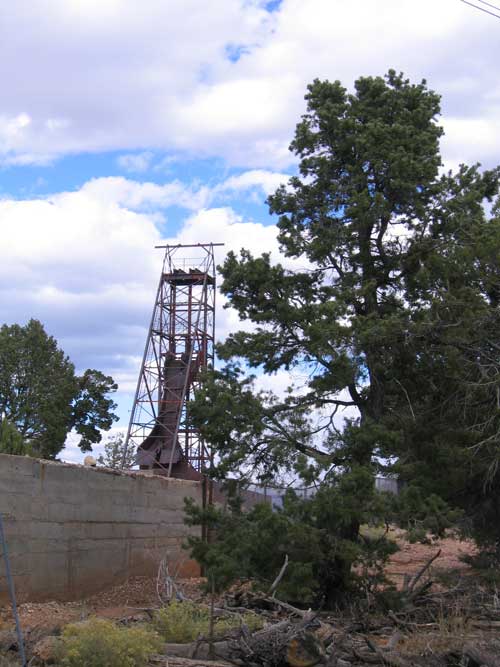Imagine commuting to and from work every day in a bucket suspended from a slender cable. At both the beginning and end of your shift, you and two colleagues would climb into a large iron bucket and traverse the 1800 feet of air between the Grand Canyon’s South Rim and the Orphan Mine, which entered the side of a canyon wall some 4000 feet above the Colorado River. Some miners simply could not imagine such a commute and would walk away from an offered job as soon as they saw the means of transportation. From 1955 until the miners drilled an elevator shaft to the ore body in 1959, the tramway system was the most efficient way to or from the only working mine within the boundaries of Grand Canyon National Park.
The Orphan Mine originated with a copper claim staked by Dan Hogan in 1893 and patented with Charlie Babbitt in 1906. After a few harrowing and disappointing years, mining stopped. There just was not enough copper in the rock to make mining in this difficult spot worthwhile. Besides, the location soon proved valuable as a tourist destination.
With four of his twenty patented acres located on the South Rim with spectacular views in every direction, Hogan capitalized on the growing popularity of the Grand Canyon National Park by building a complex that came to include cabins, stores, and a saloon. The demands of World War II closed the facility, which Hogan sold to Madeleine Jacobs in 1946. Although the National Park Service longed to acquire this one unregulated, privately-owned parcel within the park’s boundaries, federal officials chose not to compete with Jacobs for its purchase, and the land remained in private hands.
Jacobs reopened the facility to tourists and leased it to various operators, including Will Rogers, Jr., but the area’s focus soon reversed again. For some years, the land had been more valuable for tourism than for mining, but the 1951 discovery of rich uranium ore on the site soon made the Orphan Mine a key part of the uranium mining boom that stretched across the western states during the Cold War.
The Golden Crown Mining Company acquired the mine and associated property from Jacobs in 1953; three years later, the company merged with Utah-based Western Gold and Uranium, Inc., which operated the Orphan Mine for the next thirteen years. The first shipment left the Orphan Mine in April 1956. Lifted up by the tramway’s bucket, twenty tons of uranium ore was shipped to the company’s Tuba City mill for processing. In its thirteen years of active operation, the Orphan Mine produced 800,000 tons of ore, yielding 13 million pounds of uranium.
Tourists, however, continued to be an integral part of the site’s value by staying at the Grand Canyon Inn, which remained open near the mine site, and wandering into the mine office with both questions about the area and offers to pay for a ride on the tramway, which was not dismantled until 1965.
With an average of 45 men working two daily shifts, the Orphan Mine soon proved to be sitting on the richest uranium lode in a country increasingly concerned about nuclear security. When Western Gold determined that the ore body continued beyond the private property boundary and into the National Park itself, mining stalled as company officials argued with the federal government about whether federal mining laws allowed it to extract ore within the national park.
In 1960, Arizona’s U.S. Senators Barry Goldwater and Carl Hayden and Congressman Stewart Udall engaged the dispute by introducing congressional legislation that would allow the company to follow the uranium lode into the Park in exchange for the payment of royalties to the federal government and an agreement to surrender the mine and the land to the government ownership within a specified period of time. Northern Arizona business leaders, concerned about the continuation of the uranium mining industry’s economic contributions to their area, and Navajo tribal leaders, concerned about the loss of jobs at the Tuba City mill, worked together to support the legislation, which progressed slowly through the congressional process.
Also working diligently to get the bill passed, Western Gold officials decreased production at the Orphan Mine. Strategizing that public outrage could work to their advantage, they announced plans to build an eighteen-story, six-hundred-room hotel that would flow over the edge of the Grand Canyon. As a publicly-held company, Western Gold argued that it had a fiduciary responsibility to its stockholders. If it could not mine, it would operate a hotel. Angry letters soon poured into Congress, demanding that the Park be saved from this potential eyesore, but not necessarily from mining.
After a protracted congressional battle punctuated by a vacillating Goldwater, arguments that the mine was necessary for national security and the Arizona economy won out. In 1962, President John F. Kennedy signed the Orphan Mine Bill, which allowed the mine’s owners to follow the ore body from private land into public land for a specified period of time. The grandiose hotel plan abandoned and the Grand Canyon Inn required to close in 1966, the company focused on increasing its efforts to produce uranium. By the time mining halted—for good, essentially—in 1969, approximately sixty percent of its total production had come from inside the Grand Canyon National Park’s boundaries.
Pursuant to the terms of the Orphan Mine Bill, the National Park Service finally acquired the land, including the abandoned mine and its numerous outbuildings, in 1987. Over 20 years later, the Park Service removed all physical signs of mining, but contamination from low-level radiation remains. The National Park Service plans to release an environmental assessment of this and other abandoned mines in the Grand Canyon National Park in 2010.
Although the Orphan Mine’s headframe no longer stands, it lives on in photographs and memories as a potent symbol of Americans’ changing relationship with the Grand Canyon. The support of uranium mining expressed by many northern Arizona and Navajo leaders in the pre-Cuban missile crisis era evaporated over the subsequent decades as health concerns escalated; currently, the opposition to continued uranium mining in and near the Grand Canyon is fierce. In 1992, the Navajo Nation’s President banned uranium mining on Navajo lands, which was affirmed by the Diné Natural Resources Protection Act approved by the Navajo National Council in 2005. In 2008, Arizona Congressman Raul Grijalva introduced a bill in the U.S. House of Representatives to prohibit uranium mining in the Grand Canyon, and the U.S. Department of Interior announced a two-year moratorium on all mining activities in a million acres under its control near the Canyon. In 2009, a consortium of environmental groups filed suit against the Federal Government to stop a pending uranium operation.
Written By Dana Bennett
References:
- Michael A. Amundson, “Mining the Grand Canyon to Save It: The Orphan Lode Uranium Mine and National Security,”Western Historical Quarterly 32 (Autumn 2001): 320-346.
- Michael F. Anderson. Polishing the Jewel: An Administrative History of Grand Canyon National Park. Grand Canyon: Grand Canyon Association, 2000.
- Michael F. Anderson. Living At the Edge: Explorers, Exploiters and Settlers of the Grand Canyon Region. Grand Canyon: Grand Canyon Association, 1998.
- Todd R. Berger, It Happened at Grand Canyon (Guilford, Connecticut: Globe Pequot Press, 2008).
- Maurice Castagne, P.E. Grand Canyon Orphan Mine (Mina, Nevada: Grand Canyon Orphan, 2004).
- “Interior to halt uranium mining at Grand Canyon,” USA Today, July 20, 2009. Link: http://www.usatoday.com/news /washington/2009-07-20-uranium-grand-canyon_N.htm
- Navajo Nation Council. Resolution CAP-18-05, “Diné Natural Resources Protection Act.” April 29, 2005. Click for link.
- Navajo Nation Office of the President. Executive Order Moratorium on Uranium Mining. Dec. 9, 1992.
- “Orphan Mine cleanup begins next month,” Grand Canyon News, October 8-14, 2008, p. 1.
- Kurt Repanshek. “Lawsuit Aims to Halt Uranium Mine Near Grand Canyon National Park,”
National Parks Traveler, November 17, 2009. Link:
http://www.nationalparkstraveler.com/2009/11/lawsuit-aims-halt-
uranium-mine-near-grand-canyon-national-park4944







